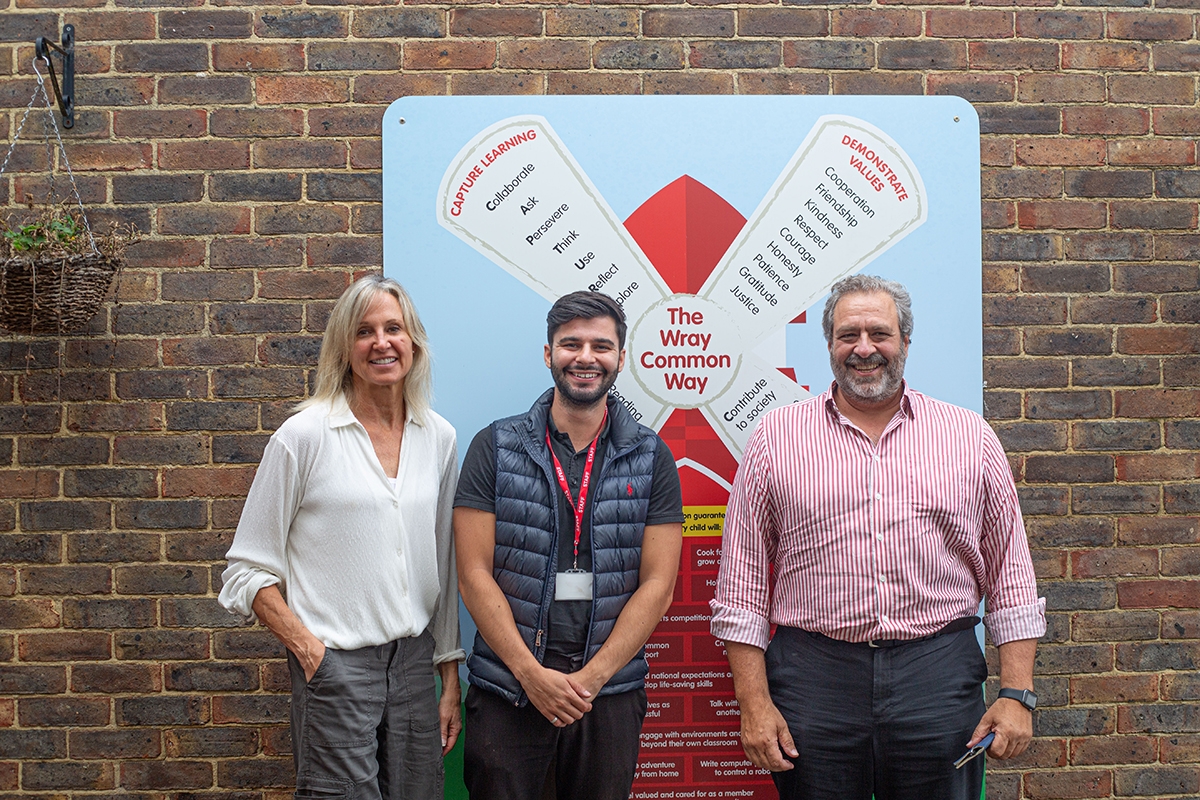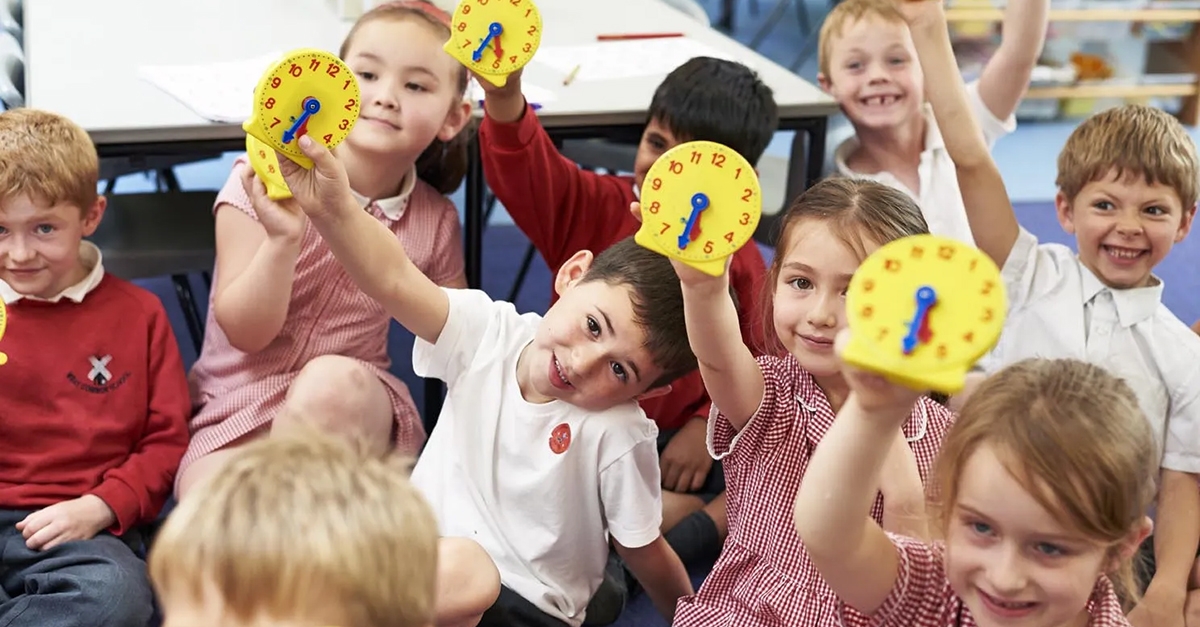A conversation with Felix Savedra: Insights from a primary school maths lead
Felix Savedra is a Year 3 Class Teacher and Maths Lead at Wray Common Primary School, which is a two-form entry school with 15 classes that is part of the Greensand Trust. The school is located in Reigate, Surrey. With six years of teaching experience and two years as Maths Lead, Felix has been integral to the school's adoption and success with the Maths — No Problem! programme, which they have used for seven years.
Felix began his career at Wray Common, starting as a TA in Reception. He quickly fell in love with primary school learning, particularly maths. He later became a Year 1 teacher, took on some subject responsibilities, and eventually became the PE and then Maths Lead. Here, he shares his journey and insights on teaching maths to primary school children.

Felix Savedra (middle), along with Robin Potter and Andy Psarianos of Maths — No Problem!
How did you become maths lead?
"There was a very experienced maths lead who moved to a different school, and I put my name forward for the job, even though it felt like a bit of a jump since I’d only been teaching for four years. I really enjoy the subject and feel confident and knowledgeable about it."
What do you love about primary learning?
"It's having that bond and building those relationships with your class. The age is also crucial — they so want to learn, they so want to grow. They're like sponges at the primary school age, thirsty for knowledge, and I love working alongside that."
What are some challenges in teaching maths for that age?
"We don't do sets at primary school. Maths — No Problem! is good because it has that high ceiling and low floor, so it really does meet the needs of all students. I’m a Year 3 teacher, you've got some children working at a Year 1 level, and some children who could easily be working at a Year 4 or Year 5 level — and it's kind of that ‘can you meet the needs of all children with a lesson through support and challenge.’ I would say that's probably the greatest difficulty.”
He says Maths — No Problem! lessons are designed to challenge all children while being accessible to lower-attaining students. For example, with three pots of flowers (3, 4, and 5 flowers), lower-attaining children can count the flowers one-by-one, while higher-attaining children might recognize patterns or more advanced methods, such as moving one of the flowers to create three groups of four.
Why are you an advocate of the Maths — No Problem! approach?
Felix explains that the school chose Maths — No Problem! due to the strong attainment and research from Singapore. The clear progression of knowledge and skills from Year 1 to Year 6 ensures consistency and builds on prior learning, which is crucial for effective maths education.
Without a programme across the school, Felix says, children could learn a topic in Year 1, and then repeat that topic in Year 2, or learn something that doesn’t quite follow on.
By having Maths — No Problem! across the school means each year group has a consistent language and calculation policy going up through Year 6, with methods building on one another, he says.
“It’s really important that there’s consistency with how maths is taught across the school. Ninety-five percent of the time, if you walk into a maths lesson, it will look very similar in each class — the Explore task, the Guided Practice, the Independent Practice — so there is that consistency of how it's being taught.”
Felix says it’s also a big advantage in terms of resources — teacher workload and planning — because teachers don’t have to think up lessons from scratch.
Transform Your Maths Assessment
Insights — our online assessment tool — gives you instant, powerful data to identify gaps and improve results.

How do your colleagues feel about working with a textbook?
He acknowledges that some teachers in the UK don’t like using textbooks because they believe it takes away their autonomy. But there tends to be a shift once teachers start using the books, he says.
“We’ve had a very low staff turnover. We have a lot of teachers who have been with us for a while who are bought in on the programme. We had one teacher who joined recently, and he said things like, ‘There's no autonomy. It's very procedural.’ And we sent him on the three-day Maths — No Problem! training course, and my God, he came back and now he is the biggest advocate, he absolutely loves it.”
What does maths look like at Wray Common?
Felix says Wray Common has three strands: core lessons (Maths — No Problem! lessons), early morning maths for fluency and gap-plugging, and interventions like pre-teaching.
Felix explains that the early morning maths is like a rolling start, where as soon as the children come in, there’s a set of questions on the board that start easy and get progressively harder. They use a school ‘Target Tracker,’ which is an assessment tool where teachers RAG (red/amber/green) maths statements for each child. The tracker highlights individual and whole class gaps in knowledge, which can then be used to adapt teaching and lesson planning.
“Once we complete the end of unit review in the maths book, we say, right, that child can do that, that child can’t do that, that child is not even beginning to learn that skill, it gives you really helpful data to say this particular skill children in your class find tricky. Those are questions we would practise in early morning maths. It’s an activity to plug gaps in knowledge, and a bit of practice for those who are already quite strong.”
The third component, Felix says, is interventions, which mostly involves pre-teaching.
“A lot of research shows that, if you teach a lesson, and you realise those five children didn't get it, and then you reflexively react to that, that's less impactful than if the day before you think, right, I don't think those five children are going to get it, so I'm going to take those five children out the day before and give them a bit of vocabulary, a bit of knowledge that they need for the next day's lesson, that is far more impactful, because then they can access that whole lesson. Whereas maybe if they didn't have that pre teaching, they would be a bit passive in that lesson.”

Children at Wray Common Primary School in Reigate work together to solve problems.
Can you share some success stories?
“Our maths attainment is significantly above the national average, with our whole school average of 83% who met age expectations this year and 29% exceeding standards. We also have high enjoyment rates among students, with 85% saying they enjoy maths. External reviews of our curriculum and teaching quality have been very positive, and we have successfully helped other schools adopt the Maths — No Problem! programme.”
What challenges did you face in implementing the programme?
“It’s a whole new approach to teaching maths — the structure of the lessons changed, the language changed, the resources changed. There were a lot of people who were very used to doing what they were doing, and there was maybe a bit of resistance.”
How important is training for implementing the programme?
Felix says proper training is crucial. “I was lucky enough to go on the three-day training with Ban Har himself. I thought I knew enough before, but I learned so much. The value of that training is really, really evident. I get that some people can go on that training and share back what they’ve learned, but the quality of the training from Maths — No Problem! is top, so it is really impactful and important.”
What advice do you have for schools implementing the programme?
"Send as many people on the training as possible.”
Felix says observing Maths — No Problem! lessons first-hand is very impactful. He recommends ensuring consistent training and exposure to how the programme works in practice.
Felix's dedication to maths education and his leadership at Wray Common highlight the effectiveness of the Maths — No Problem! Programme. His insights provide valuable guidance for other educators looking to implement or enhance their maths curriculum.
Learn more
Nine years on, a subject lead reflects on Maths — No Problem!
Matt Bland on teaching children to problem-solve and how to involve parents (Part 1)
Laurice Prempeh on problem-solving and empowering children to learn maths

